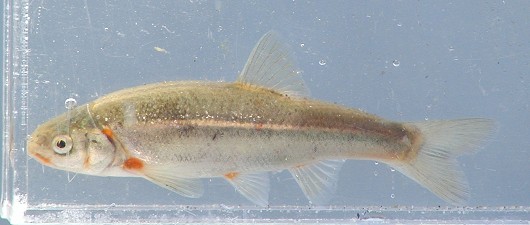California Roach
-
Scientific NameLavinia symmetricus
-
NativeNative Species
-
Identification
 California roach. Captured from the Gualala River. Photo by Carl Page, ARS Consulting.
California roach. Captured from the Gualala River. Photo by Carl Page, ARS Consulting.- Small chunky fish, usually less than 100 mm TL, rarely exceed 120 mm SL
- Large head, small downward turned mouth
- Coloration: body is usually gray to blue on top, silvery underside
- Spawning adults: may develop orange and red colorations on chin and paired fins
- Breeding males may develop series of nodes or tubercles on head
- Fin rays: dorsal 7-9, anal 6-8
- Lateral line scales: 47-63
-
Life History
California roach are capable of adapting to varying habitats from coastal streams to mountain foothill streams. They are predominately found in small warm streams but are capable of thriving in larger colder streams with diverse conditions. They may actually occupy several different habitat types within a single drainage. Extreme tolerance includes temperatures ranging from 30-35ºC and dissolved oxygen levels as low as 1-2 ppm. In-stream location may vary depending on geography and predators. When California roach share water with Sacramento pikeminnows, roach will stick to the stream margins, whereas in the absence of these piscivorous fish roach may venture into deeper pools. California roach are omnivorous and diet may depend on stream size and food availability. In smaller rivers roach feed mostly on filamentous algae, supplementing their diet with crustaceans and insects. In larger rivers these fish may focus on a diet of aquatic insects year round. The growth and development of California roach is largely seasonally dependent. Most growth occurs during the summer months and roach may grow 20-40 mm in a year. Most fish of this species reach sexual maturity at age 2-3 and rarely live beyond three years total. Spawning occurs in March through early July, and timing is temperature dependent. California roach breed in gravel beds or riffles where groups of females lay eggs on and into the substrate. One or two males follow each female closely to fertilize the groups of eggs. Each female may produce 250-2,000 eggs per year depending on body size. The eggs hatch in 2-3 days, but the larvae remain in the protection of the gravel substrate before emerging to swim.
-
Links to Other ResearchN / A
-
Watershed
-
Alisal-Elkhorn Sloughs Watershed
-
Big-Navarro-Garcia Watershed
-
Bodega Bay Watershed
-
Carmel Watershed
-
Carrizo Plain Watershed
-
Cottonwood Headwaters Watershed
-
Coyote Watershed
-
Cuyama Watershed
-
Estrella Watershed
-
Goose Lake Watershed
-
Gualala-Salmon Watershed
-
Honcut Headwaters Watershed
-
Lower American Watershed
-
Lower Bear Watershed
-
Lower Butte
-
Lower Cache Watershed
-
Lower Cottonwood Watershed
-
Lower Eel Watershed
-
Lower Feather Watershed
-
Lower Pit Watershed
-
Lower Sacramento Watershed
-
McCloud Watershed
-
Middle Fork Eel Watershed
-
Middle Fork Feather Watershed
-
Middle San Joaquin-Lower Merced-Lower Stanislaus Watershed
-
Mill Watershed
-
North Fork American Watershed
-
North Fork Feather Watershed
-
Pajaro Watershed
-
Panoche-San Luis Reservoir Watershed
-
Russian Watershed
-
Sacramento Headwaters Watershed
-
Sacramento-Lower Cow-Lower Clear Watershed
-
Sacramento-Lower Thomes Watershed
-
Sacramento-Stone Corral Watershed
-
Sacramento-Upper Clear Watershed
-
Salinas Watershed
-
Salmon Watershed
-
San Francisco Bay Watershed
-
San Francisco Coastal South Watershed
-
San Joaquin Delta Watershed
-
San Lorenzo-Soquel Watershed
-
San Pablo Bay Watershed
-
South Fork American Watershed
-
South Fork Eel Watershed
-
Suisun Bay Watershed
-
Tomales-Drake Bays Watershed
-
Tulare-Buena Vista Lakes Watershed
-
Upper Bear Watershed
-
Upper Butte
-
Upper Cache Watershed
-
Upper Calaveras Watershed
-
Upper Chowchilla-Upper Fresno Watershed
-
Upper Coon-Upper Auburn Watershed
-
Upper Cosumnes Watershed
-
Upper Cow-Battle Watershed
-
Upper Deer-Upper White Watershed
-
Upper Dry Watershed
-
Upper Eel Watershed
-
Upper Elder-Upper Thomes Watershed
-
Upper Kaweah Watershed
-
Upper King Watershed
-
Upper Los Gatos-Avenal Watershed
-
Upper Merced Watershed
-
Upper Mokelumne Watershed
-
Upper Pit Watershed
-
Upper Putah Watershed
-
Upper San Joaquin Watershed
-
Upper Stanislaus Watershed
-
Upper Stony Watershed
-
Upper Tule Watershed
-
Upper Tuolumne Watershed
-
Upper Yuba Watershed
-
Please note, watersheds are at the USGS 8-digit Hydrologic Unit Code (HUC) scale, so they often include a lot of sub-watersheds. If a species occurs in any sub-watershed within the HUC, the species appears within the HUC. Link to an EPA page that shows HUCs.
